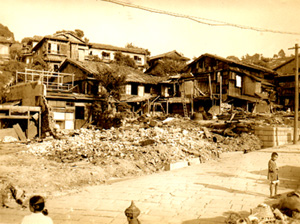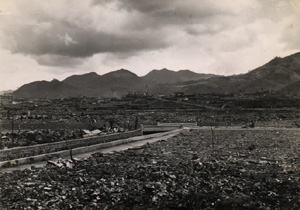Rescue Mission to Kyushu
by Charles Sterling Berry (1919-1964)
1 | 2
On August 8, 1945, the United States exploded a nuclear bomb called "Fat Man" over the Japanese city of Nagasaki, prompting Emperor Hirohito's official surrender--and the end of World War II--on September 10.
Just a few days after Japan's surrender, a team of Allies entered Nagasaki Harbor to liberate prisoners of war from the Japanese camps on Kyushu island. Charles Sterling Berry, a young Naval pharmacist and crew member of the USS HAVEN, took photographs of the atomic bomb's devestation in Nagasaki, and subsequently wrote a journal chronicling the visit to Kyushu.
A
copy of the original document was provided to the USS HAVEN Reunion
by Margaret Curran on 14 May 2003.
Aboard
the USS HAVEN (AH12)
Nagasaki Harbor, Japan
15 September 1945
With the rescue of approximately 10,000 persons who have been held as prisoners of war and internees by Japan in Kyushu as its goal, a naval task force under the command of Rear Admiral Frank G. Fahrion, USN, arrived in the narrow harbor of Nagasaki on Sept. 11 at 2600 (East longitude date, local time). Headed by the USS WICHITA, veteran heavy cruiser which carries Admiral Fahrion's flag, the task force, consisting of the Navy hospital ship, HAVEN, two destroyers, the MUGFORD and SMITH, seaplane tender CORSON and destroyer transport WEBER, threaded its way through a minefield at the entrance of the harbor under a leaden sky and drizzling rain which restricted visibility.
A Japanese pilot, Lt. Comdr. Tauchi Hisao, Japanese Imperial Naval Reserve, was taken aboard the WICHITA about 20 miles from the entrance to the harbor to guide the ships through the minefield and narrow channel. Due at 0800, he arrived at noon, during which time minesweeps circled the task group. One of the destroyers sunk a mine by machine gun fire about 1000 yards from the WICHITA. The ships had made their way from Buckner Bay, Okinawa, uneventfully, having left at 0600, 10 Sept. 1945.
After reaching the entrance to the thin river-like harbor, the ships proceeded slowly in single file between high hills, dodging hulls of ships sunk by bombing raids and passing ship yards and a few launched but no completed merchant ships. Several Japs in nondescript fishing boats of various sizes gazed apparently impassively at the ships. From their battle stations, for all ships were at General Quarters--just in case--the ship's crew could see some midget subs in one yard. Looking toward the hills, one could see the terraced agricultural plots typical of all Japan. Vertical victory gardens, was the term given them. Below the farming area, there were many clusters of closely grouped thatched roofs, rising in steps from the water's edge. Two small boys were the only Japs to give any welcoming gestures, waving at the ships.
As the small task force 'walked a tight rope' up the channel, more and more damaged buildings began to appear. Later it was learned that practically all the damage in the whole area was caused by the atomic bomb. Eventually, the cruiser drew even with the relatively undamaged docks and the anchor was dropped, while the Haven drew along side to moor and tie up for the big job that lay ahead. Immediately a Marine detachment of 70 men was disembarked and sent ashore. Veterans of landings under fire on other islands in the Pacific, they were prepared for any eventuality. The landing was made without incident, several groups of Japs watching with no indication of their feelings being apparent. The Marines quickly cleared a three square block area of Nips and inspected the vicinity.
Materializing
from the lengthening shadows to greet Admiral Fahrion as he inspected
the dock area where General Taniguchi, commanding Japanese forces in
this area, and Wakamatsu Nagano, Governor of the Nagasaki prefecture.
They asked if they could be of assistance and in turn were queried if
they knew why the Navy was present. "To release unfortunate prisoners
of war," was the reply. Actually they wanted to surrender formally but
were discouraged by the admiral.

Shortly after the Marines landed, the hospital ship USS HAVEN was moored to the Dejima Wharf ready to receive evacuees with equipment rivalling the most modern hospitals. Within a few hours a flight officer from a B-29 which crashed recently while on a food dropping mission to prison camps was taken aboard. The only survivor of 14, he had been carried from a mountain side by natives and was taken to a prison camp on the edge of the city. In need of medical attention he was brought to the HAVEN, where it was discovered both his legs were fractured. Interviewed at his bed side, he reported considerate care on the part of the natives who rescued him.
Early Wednesday morning, Sept. 12th, a conference was held with local public health, railroad and military officials, with Colonel Owen Griffin of the US Army and Commodore M. D. Willcutts (MC) USN, outlining to the Japs the plans for evacuating the prisoners. The local persons pledged their full aid. All camps to be evacuated, except the first one, are within two miles of a railroad, and a few hospital cars will be used to supplement regular coaches. Also present were representatives from Australia, Netherlands, East Indies, And Canada who came to assist in handling their own nationals.
While the conference was being held, some 200 Jap workmen began clearing up the dock area. Under the enthusiastic guidance of Canadian army officers, the natives wasted no time, once they started working. They had waited patiently, quietly and almost motionlessly in columns of four for an hour. Most of them were ex-soldiers, judging from their garments. At the same time, a working party from the HAVEN began to install double rows of showers made aboard the ship during the previous night. By late afternoon the rubbish and rubble had been cleared, the showers were ready and a modern building which had formerly housed the dock offices was thoroughly cleaned and disinfected.
The
task force was strengthened Tuesday by the arrival of the USS CHENAGO,
an escort carrier, which put in with four other ships. The CHENAGO,
stripped of her fighting planes, has been converted to a transport and
can accommodate 1500 evacuees.


Click image on right to enlarge
Late Tuesday afternoon 20 Naval officers and enlisted personnel, most of them photographers, were driven in a highly polished Buick Centry sedan with white side-wall tires, and a Chevrolet truck, to inspect the area devestated by the atomic bomb. The transportation was furnished by Captain Yadomi, chief of the military police [and] interpreter. Despite a weak battery which made it necessary for the truck to push, the Buick was in excellent condition. Gasoline was being used on this trip, although in common with most of the few other vehicles seen in the city, it had a charcoal burner in the luggage compartment at the rear. Gasoline is very scarce and is not available for civilian use.
Driving north from the dock area, the completely ruined section starts about one mile from the harbor and extends along a two mile wide valley for approximately four miles between hills about 1500 feet high. There is no disintegration of matter. However, the area is flattened. Only a few reinforced concrete walls, and one lonsesome Japanese arch stand in the midst of a vast amount of rubble. The great Mitsubishi Iron Works, nearly a mile long and four blocks wide, is a mass of twisted and tangled steel girders. In one block which formerly housed a factory, only the seared lathes, drills and other machine tools are standing.
Natives who saw the bomb first saw a ball of fire in the air, then a rumbling, thunderous roar reverberated for several minutes, during which time the ball broke into many smaller fiery parts. The fires caused directly or indirectly burned intensely for ten days. Very little fire protection has been noticed in the city; only two light trucks and several small wagons resembling children's toys [having] been seen.